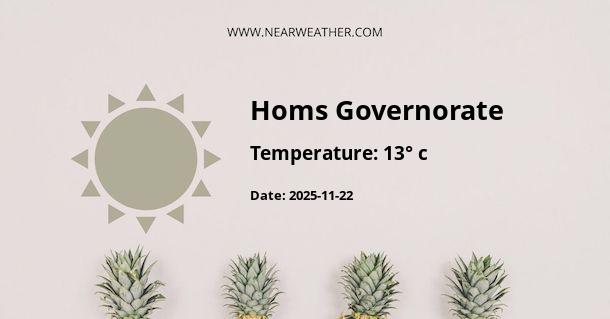Climate and Weather in Muḩāfaz̧at Ḩimş, Syria
Geographical Overview
Muḩāfaz̧at Ḩimş, also known as Homs Governorate, is a prominent region in Syria, situated in the western part of the country. The governorate is characterized by its diverse topography, with a mix of mountains, plateaus, and plains, which significantly influence the climate and weather conditions.
Climate Classification
The climate in Muḩāfaz̧at Ḩimş is classified under the Mediterranean climate category, specifically the Hot-summer Mediterranean climate (Csa) according to the Köppen climate classification. This is characterized by hot, dry summers and mild, wet winters.
Annual Weather Overview
The weather in Muḩāfaz̧at Ḩimş varies widely throughout the year, with temperatures ranging from an average low of 4°C (39.2°F) in winter to an average high of 34°C (93.2°F) in summer. The region receives most of its rainfall in winter, with an average annual precipitation of approximately 450 mm.
Seasonal Weather Patterns
Winter
The winter season in Muḩāfaz̧at Ḩimş extends from December to February. During this period, the region experiences its coldest and wettest conditions. Temperatures can drop as low as 4°C (39.2°F), and the region receives the majority of its annual rainfall.
Spring
Springtime in Muḩāfaz̧at Ḩimş, which lasts from March to May, is characterized by mild temperatures and a significant decrease in rainfall. The average temperature during this season ranges from 11°C (51.8°F) to 24°C (75.2°F).
Summer
Summers in Muḩāfaz̧at Ḩimş are typically hot and dry, extending from June to August. The average temperature can soar up to 34°C (93.2°F) during the day, with very little rainfall.
Autumn
Autumn in Muḩāfaz̧at Ḩimş, from September to November, is marked by a gradual decrease in temperature and an increase in precipitation. The average temperature during this season ranges from 16°C (60.8°F) to 28°C (82.4°F).
Impact of Climate on Local Life
The climate of Muḩāfaz̧at Ḩimş significantly influences the lifestyle and economic activities of the local population. Agriculture is a vital sector in the region, with crops such as wheat, barley, and various fruits being cultivated. The hot, dry summers and mild, wet winters provide suitable conditions for these crops.
Climate Change Considerations
Like many regions worldwide, Muḩāfaz̧at Ḩimş is not immune to the impacts of climate change. Rising temperatures and changing precipitation patterns could potentially disrupt agricultural activities and negatively affect water availability in the region. Therefore, climate resilience and adaptation strategies are crucial for the region's sustainable future.
"Understanding the climate and weather patterns of Muḩāfaz̧at Ḩimş is crucial, not just for its residents but also for visitors and investors. This knowledge can guide decision-making in various sectors such as agriculture, tourism, and infrastructure development." - Climate Expert.
Conclusion
In conclusion, Muḩāfaz̧at Ḩimş experiences a Mediterranean climate characterized by hot, dry summers and mild, wet winters. This climate significantly impacts the region's lifestyle and economy, particularly the agricultural sector. With the looming threat of climate change, understanding and adapting to these weather patterns is of paramount importance.
A - Homs Governorate's Latitude is 34.250000 & Longitude is 38.000000.
A - Weather in Homs Governorate is 11° today.
A - Climate Conditions in Homs Governorate shows clear sky today.
A - Humidity in Homs Governorate is 41% today.
A - Wind speed in Homs Governorate is 6.3 km/h, flowing at 338° wind direction. today.
